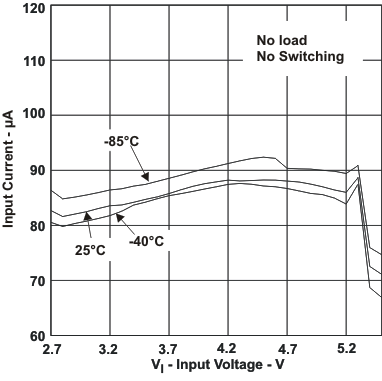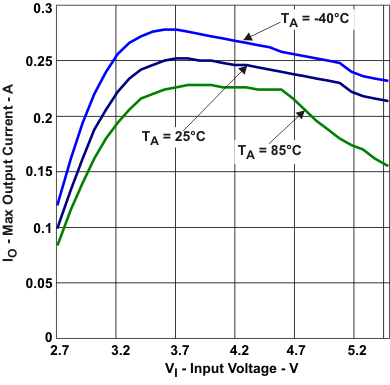-
TPS60150 5-V, 140-mA Charge-Pump
- 1 Features
- 2 Applications
- 3 Description
- 4 Revision History
- 5 Pin Configuration and Functions
- 6 Specifications
- 7 Detailed Description
- 8 Application and Implementation
- 9 Power Supply Recommendations
- 10Layout
- 11Device and Documentation Support
- 12Mechanical, Packaging, and Orderable Information
- IMPORTANT NOTICE
Package Options
Mechanical Data (Package|Pins)
- DRV|6
Thermal pad, mechanical data (Package|Pins)
- DRV|6
Orderable Information
TPS60150 5-V, 140-mA Charge-Pump
1 Features
- 2.7-V to 5.5-V Input Voltage Range
- Fixed Output Voltage of 5 V
- Maximum Output Current: 140 mA
- 1.5-MHz Switching Frequency
- Typical 90-μA Quiescent Current at No Load Condition (Skip Mode)
- X2 Charge Pump
- Hardware Enable and Disable Function
- Built-in Soft Start
- Built-in Undervoltage Lockout Protection
- Thermal and Overcurrent Protection
- Available in a 2-mm × 2-mm 6-Pin SON Package with 0.8-mm Height
2 Applications
- USB On-the-Go (OTG)
- HDMI
- Portable Communication Devices
- PCMCIA Cards
- Mobile Phones, Smart Phones
- Handheld Meters
3 Description
The TPS60150 device is a switched capacitor voltage converter that produces a regulated, low noise, and low-ripple output voltage of 5 V from an unregulated input voltage.
The 5-V output can supply a minimum of 140-mA current.
The TPS60150 device operates in skip mode when the load current falls less than 8 mA under typical condition. In skip mode operation, quiescent current is reduced to 90 μA.
Only 3 external capacitors are needed to generate the output voltage, therefore saving PCB space.
Inrush current is limited by the soft-start function during power on and power transient states.
The TPS60150 device operates over a free-air temperature range of –40°C to 85°C. The device is available with a small 2-mm × 2-mm 6-pin SON package (QFN).
Device Information(1)
| PART NUMBER | PACKAGE | BODY SIZE (NOM) |
|---|---|---|
| TPS60150 | WSON (6) | 2.00 mm × 2.00 mm |
- For all available packages, see the orderable addendum at the end of the data sheet.
space
space
Typical Application Schematic

Efficiency vs Input Voltage

4 Revision History
Changes from B Revision (February 2011) to C Revision
- Added Pin Configuration and Functions section, ESD Ratings table, Feature Description section, Device Functional Modes, Application and Implementation section, Power Supply Recommendations section, Layout section, Device and Documentation Support section, and Mechanical, Packaging, and Orderable Information section Go
Changes from A Revision (April 2009) to B Revision
- Added the Thermal Table and deleted the Dissipation Rating TableGo
5 Pin Configuration and Functions

Pin Functions
| PIN | I/O | DESCRIPTION | |
|---|---|---|---|
| NAME | NO. | ||
| CP+ | 4 | — | Connect to the flying capacitor |
| CP– | 5 | — | Connect to the flying capacitor |
| ENA | 6 | IN | Hardware enable/disable pin (High = Enable) |
| GND | 1 | — | Ground |
| VIN | 2 | IN | Supply voltage input |
| VOUT | 3 | OUT | Output, connect to the output capacitor |
6 Specifications
6.1 Absolute Maximum Ratings
Over operating free-air temperature range (unless otherwise noted) (1)| MIN | MAX | UNIT | ||
|---|---|---|---|---|
| VIN | Input voltage (all pins) | –0.3 | 7 | V |
| TA | Operating temperature | –40 | 85 | °C |
| TJ | Maximum operating junction temperature | 150 | °C | |
| Tstg | Storage temperature | –55 | 150 | °C |
6.2 ESD Ratings
| VALUE | UNIT | |||
|---|---|---|---|---|
| V(ESD) | Electrostatic discharge | Human body model (HBM), per ANSI/ESDA/JEDEC JS-001(1)(2) | ±2000 | V |
| Charged-device model (CDM), per JEDEC specification JESD22-C101(3) | ±500 | |||
6.3 Recommended Operating Conditions
6.4 Thermal Information
| THERMAL METRIC(1) | TPS60150 | UNIT | |
|---|---|---|---|
| DRV (WSON) | |||
| 6 PINS | |||
| RθJA | Junction-to-ambient thermal resistance | 69.1 | °C/W |
| RθJC(top) | Junction-to-case (top) thermal resistance | 79.8 | °C/W |
| RθJB | Junction-to-board thermal resistance | 38.6 | °C/W |
| ψJT | Junction-to-top characterization parameter | 1.2 | °C/W |
| ψJB | Junction-to-board characterization parameter | 38.4 | °C/W |
| RθJC(bot) | Junction-to-case (bottom) thermal resistance | 9.2 | °C/W |
6.5 Electrical Characteristics
VIN = 3.6 V, TA = –40°C to 85°C, typical values are at TA = 25°C, C1 = C3 = 2.2 μF, C2 = 1 μF (unless otherwise noted)| PARAMETER | TEST CONDITIONS | MIN | TYP | MAX | UNIT | |
|---|---|---|---|---|---|---|
| POWER STAGE | ||||||
| VIN | Input voltage range | 2.7 | 5.5 | V | ||
| VUVLO | Undervoltage lockout threshold | 1.9 | 2.1 | V | ||
| IQ | Operating quiescent current | IOUT = 140 mA, Enable = VIN | 4.7 | mA | ||
| IQskip | Skip mode operating quiescent current | IOUT = 0 mA, Enable=VIN (no switching) | 80 | μA | ||
| IOUT = 0 mA, Enable = VIN(minimum switching) | 90 | μA | ||||
| ISD | Shut down current | 2.7 V ≤ VIN ≤ 5.5 V, Enable = 0 V | 1 | μA | ||
| VOUT | Output voltage(1) | IOUT ≤ 50 mA, 2.7 V ≤ VIN < 5.5 V | 4.8 | 5 | 5.2 | V |
| VOUT(skip) | Skip mode output voltage | IOUT = 0 mA, 2.7 V ≤ VIN ≤ 5.5 V | VOUT + 0.1 | V | ||
| FSW | Switching frequency | 1.5 | MHz | |||
| SSTIME | Soft-start time | From the rising edge of enable to 90% output | 150 | μs | ||
| OUTPUT CURRENT | ||||||
| IOUT_nom | Maximum output current | VOUT remains from 4.8 V to 5.2 V, 3.1 V ≤ VIN ≤ 5.5 V |
120 | mA | ||
| 3.3 V < VIN < 5.5 V | 140 | |||||
| IOUT_short | Short circuit current(2) | VOUT = 0 V | 80 | mA | ||
| RIPPLE VOLTAGE | ||||||
| VR | Output ripple voltage | IOUT = 140 mA | 30 | mV | ||
| ENABLE CONTROL | ||||||
| VHI | Logic high input voltage | 2.7 V ≤ VIN ≤ 5.5 V | 1.3 | VIN | V | |
| VLI | Logic low input voltage | –0.2 | 0.4 | V | ||
| IHI | Logic high input current | 1 | μA | |||
| ILI | Logic low input current | 1 | μA | |||
| THERMAL SHUTDOWN | ||||||
| TSD | Shutdown temperature | 160 | °C | |||
| TRC | Shutdown recovery | 140 | °C | |||
6.6 Typical Characteristics


7 Detailed Description
7.1 Overview
The TPS60150 regulated charge pump provides a regulated output voltage for various input voltages. The TPS60150 device regulates the voltage across the flying capacitor to 2.5 V and controls the voltage drop of Q1 and Q2 while a conversion clock with 50% duty cycle drives the FETs.
 Figure 3. Charging Mode
Figure 3. Charging Mode
During the first half cycle, Q2 and Q3 transistors are turned on and flying capacitor, CF, will be charged to 2.5 V ideally.
 Figure 4. Discharging Mode
Figure 4. Discharging Mode
During the second half cycle, Q1 and Q4 transistors are turned on. Capacitor CF will then be discharged to output.
Use Equation 1 to calculate the output voltage.

The output voltage is regulated by output feedback and an internally compensated voltage control loop.
7.2 Functional Block Diagram

7.3 Feature Description
7.3.1 Enable
An enable pin on the regulator is used to place the device into an energy-saving shutdown mode. In this mode, the output is disconnected from the input, and the input quiescent current is reduced to 10 μA maximum.
7.3.2 Undervoltage Lockout
When the input voltage drops, the undervoltage lockout prevents misoperation by switching off the device. The converter starts operation again when the input voltage exceeds the threshold, provided the enable pin is high.
7.3.3 Thermal Shutdown Protection
The regulator has thermal shutdown circuitry that protects it from damage caused by overload conditions. The thermal protection circuitry disables the output when the junction temperature reached approximately 160°C, allowing the device to cool. When the junction temperature cools to approximately 140°C, the output circuitry is automatically reenabled. Continuously running the regulator into thermal shutdown can degrade reliability. The regulator also provides current limit to protect itself and the load.
7.4 Device Functional Modes
7.4.1 Soft Start
An internal soft start limits the inrush current when the device is being enabled.
7.4.2 Normal Mode and Skip Mode Operation
The TPS60150 device has skip mode operation as shown in Figure 5. The TPS60150 device enters skip mode if the output voltage reaches 5 V +0.1 V and the load current is less than 8 mA (typical). In skip mode, the TPS60150 device disables the oscillator and decreases the prebias current of the output stage to reduce the power consumption. Once the output voltage dips less than the threshold voltage of 5 V +0.1 V, the TPS60150 device begins switching to increase output voltage until the output reaches 5 V +0.1 V. When the output voltage dips less than 5 V, the TPS60150 device returns to normal pulse width modulation (PWM) mode; thereby reenabling the oscillator and increasing the prebias current of the output stage to supply output current.
The skip threshold voltage and current depend on input voltage and output current conditions.
 Figure 5. Normal Mode and Skip Mode Operation
Figure 5. Normal Mode and Skip Mode Operation
7.4.3 Short Circuit Protection
The TPS60150 device has internal short circuit protection to protect the IC when the output is shorted to ground. To avoid damage when output is shorted to ground, the short circuit protection circuitry senses output voltage and clamps the maximum output current to 80 mA (typical).
 Figure 6. Maximum Output Current Capability and Short Circuit Protection
Figure 6. Maximum Output Current Capability and Short Circuit Protection